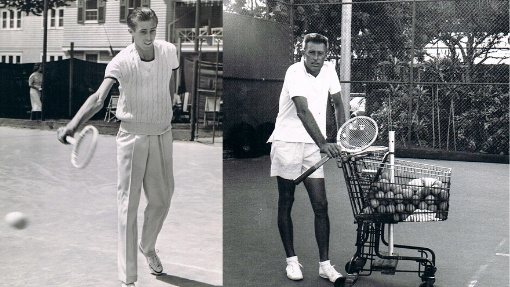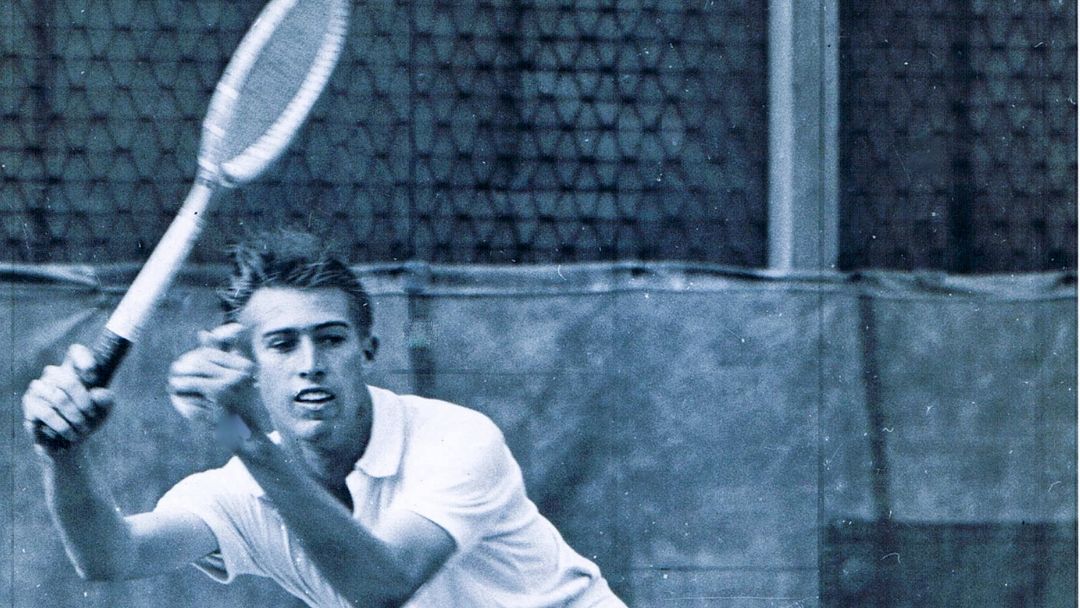Welby Van Horn was both a world-class player and a world-class teacher. Dr. Alex Mayer, whose two sons, Sandy and Gene, both had top-10 world rankings, once said that Van Horn was in a class by himself when it came to ranking tennis teachers.
As a player, Welby reached the US Open final at the age of 19 in 1939. Pete Sampras surpassed his record in 1990 when he was just 19 (and was further away from his 20th birthday). Van Horn’s playing career was interrupted by World War II. He only played three Grand Slams because he accepted part-time lesson money while he worked full-time in an aircraft factory. In the 1040’s, Welby won both the National Professional Singles and National Professional Doubles titles.

As a teacher, Welby developed his own system of instruction. It was his intellect and independence that allowed him to assemble the best pathway for beginning a player. The Van Horn format was based on logic and principled on “balance.” Welby, a Californian, taught a small number of kids on a small number of courts (4), on the small island of Puerto Rico. But his results were big. For example, in 1959, five of his students were ranked in the Top 24 in the 15-and-under age group, which was as many as came out of Southern California that year, and more than all of Florida produced.
I worked for Welby and his system worked for my students. I have only worked with developmental players; avoiding being one who recruits players with previously accomplished results. Yes, Van Horn’s fundamentals have stood the test of time. For example, I have had my students win titles at the Boys’ National Championships in Kalamazoo, and my student’s students win titles at Kalamazoo.
FINDING THE BEST
Recently, I returned to the well – the well of true tennis genius. Welby is almost 90. I spend a couple of days talking tennis with one of my mentors. Like all great teachers, Van Horn is a life-long learner. He was excited to share new insights and new discoveries that he has made observing the game today.
I arranged for Todd Goldman, the publisher of TennisLife, to interview Welby. Todd asked Van Horn who was his best student.
Van Horn gave Charlie Pasarell honorable mention. Charlie was one of Welby’s beginner’s that he grinded and polished into the No. 1-ranked player in America. But then Welby answered the question with a true and detailed story.
He said he did not remember the name of his best student, but that he was a man in his mid-30s who attended one of his summer camps. He had played three sports; changing with the seasons. The student, as Welby explained, got his toughness from football, his footwork and touch from basketball and his service motion from baseball. Welby’s best student was an entry-level adult beginner.
This camper was a successful businessman on a mission. After attending five days of camp he went home and did exactly what Van Horn had told him. He made arrangements to return to the camp at the end of the same summer for another week. Welby’s best student was at the airport on his way home but he intentionally missed his flight to drive back and ask Welby one more question: “How do you keep score?” It was that question that made him Welby’s best student.
Van Horn, as always, was making a point. I understood. I have the privilege of being a disciple of Welby. The student did what he was told. First control your grip, then control your swing and your balance. Strategy is meaningless without strokes. Practice slowly and endlessly. Stand in front of the mirror and shadow-swing thousands of times. Hit the wall with a dead ball off of two bounces. Let the body and mind connect by doing the routines over and over. Don’t let your impulses become your habits in the beginning stages. Let the first steps be steps.
Developing Champions Takes Time
Tennis teaching and tennis learning are not “fast food.” You cannot microwave a tennis game. It has to be built—and well-built—slowly, over time.
Van Horn’s best student simply listened and followed directions. He knew practice ratios such as 15 minutes on a backboard is equivalent to one hour on court because of the number of balls hit.

What’s the rush? Most tennis players generally are going nowhere fast. A Welby-ism: “Most people play at tennis. Less than 5 percent of people play tennis.”
Van Horn is an artist and to him tennis is art. He expressed during our get-together how appreciative he is for having lived long enough to watch and study another tennis artist, Roger Federer.
Welby, like Federer, showed that efficient and effortless strokes are aesthetically appealing. Virginia Wade, the former Wimbledon champion, once said, “Winning tennis wll not lead to beautiful tennis, rather beautiful tennis will lead to winning tennis.”
Parents, understand Welby’s point. One must ask a long, long list of questions and practice a long, long list of routines before their energy goes into winning. The tennis industry has gone almost totally to a “game-based” methodology. The method is to make it fun, so the students come back and pros make more money.
But let’s slow down, have some reflective thought, and learn from a true tennis master like Welby Van Horn. Teach a “form-based” system, at least for a part of practice sessions. Maybe you’ll make a bit less money, but fellow tennis teachers, you’ll make more players. That’s what Welby did.
Do you know someone who would enjoy this article?
Please consider sharing it now.


